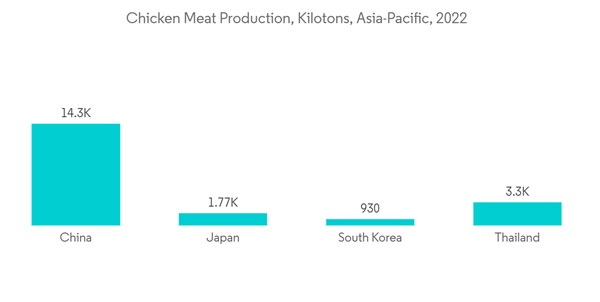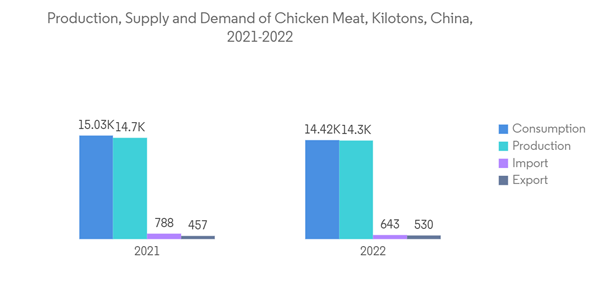The Asia-Pacific Choline Chloride Market size is estimated at USD 224.20 million in 2024, and is expected to reach USD 278.75 million by 2029, growing at a CAGR of greater than 4% during the forecast period (2024-2029).
The COVID-19 pandemic has affected several industries negatively. Lockdowns in most Asian countries caused disruptions in production and processing in the poultry and pork industry. The restrictions in freight transportation disturbed the supply chain, and the demand for these products took a hit. However, the conditions started recovering in 2021, restoring the market's growth trajectory.
· The choline chloride requirement for chicken (starter) ranges from 400 to 700 mg per kg of diet, 250 to 400 mg per kg of diet for chicken (pullets), 300-500 mg per kg for laying hens, 300-600 mg per kg for broilers, and 400-600 mg per kg of diet for ducks/geese.
· The demand for poultry comes from food consumption and the dietary needs of the masses. According to the UN Food and Agriculture Organization (FAO), the demand for food is estimated to grow by 60% by 2050. Moreover, between 2010 and 2050, animal protein production is expected to increase by around 1.7% and dairy production by around 55%.
· Population growth is the main driver for increased poultry consumption. In Asia-Pacific, meat consumption is projected to grow by 18% during the next decade. Moreover, according to the FAO, Asia is currently the largest egg-producing region, with more than 64% of the global output.
· According to Foreign Agricultural Service/USDA, Chicken meat production in China, Japan, and South Korea in 2022 was 14,300 kiloton, 1,770 kiloton, and 930 kiloton, respectively, whereas chicken meat consumption was 14,401 kiloton, 2,868 kiloton, and 1,086 kiloton, respectively.
· Consumption of poultry meat is projected to increase to 90 million ton by 2030, accounting for more than 50% of the additional meat consumed. On a per capita basis, the expected robust growth rates in poultry consumption reflect the significant role it plays in the national diets of several populous developing Asian countries, including China and India.
· Thus, demand for poultry feed will continue to grow to meet the poultry meat and food consumption in the region. Consequently, the demand for choline chloride is expected to grow substantially over the forecast period.
This product will be delivered within 2 business days.
The COVID-19 pandemic has affected several industries negatively. Lockdowns in most Asian countries caused disruptions in production and processing in the poultry and pork industry. The restrictions in freight transportation disturbed the supply chain, and the demand for these products took a hit. However, the conditions started recovering in 2021, restoring the market's growth trajectory.
Key Highlights
- Over the short term, growing demand in the poultry industry and increasing use of choline chloride in human nutritional supplements are major factors driving the growth of the market studied.
- However, outbreaks of animal diseases are likely to restrain the growth of the market studied.
- Nevertheless, the use of choline chloride as a clay stabilizer in the oil and gas industry will likely create lucrative growth opportunities for the global market.
- China is expected to have the largest choline chloride market over the forecast period due to increasing consumption in the poultry and human nutritional supplement industries.
Asia-Pacific Choline Chloride Market Trends
Poultry Feed Industry to Dominate the Market
· Choline chloride is used as a vital additive for various animal feeds, particularly chicken feed. Choline, chemically known as 2-hydroxyethyl-trimethyl ammonium hydroxide, is denoted as vitamin B4. Choline helps in the prevention of conditions such as perosis and liver enlargement in chickens.· The choline chloride requirement for chicken (starter) ranges from 400 to 700 mg per kg of diet, 250 to 400 mg per kg of diet for chicken (pullets), 300-500 mg per kg for laying hens, 300-600 mg per kg for broilers, and 400-600 mg per kg of diet for ducks/geese.
· The demand for poultry comes from food consumption and the dietary needs of the masses. According to the UN Food and Agriculture Organization (FAO), the demand for food is estimated to grow by 60% by 2050. Moreover, between 2010 and 2050, animal protein production is expected to increase by around 1.7% and dairy production by around 55%.
· Population growth is the main driver for increased poultry consumption. In Asia-Pacific, meat consumption is projected to grow by 18% during the next decade. Moreover, according to the FAO, Asia is currently the largest egg-producing region, with more than 64% of the global output.
· According to Foreign Agricultural Service/USDA, Chicken meat production in China, Japan, and South Korea in 2022 was 14,300 kiloton, 1,770 kiloton, and 930 kiloton, respectively, whereas chicken meat consumption was 14,401 kiloton, 2,868 kiloton, and 1,086 kiloton, respectively.
· Consumption of poultry meat is projected to increase to 90 million ton by 2030, accounting for more than 50% of the additional meat consumed. On a per capita basis, the expected robust growth rates in poultry consumption reflect the significant role it plays in the national diets of several populous developing Asian countries, including China and India.
· Thus, demand for poultry feed will continue to grow to meet the poultry meat and food consumption in the region. Consequently, the demand for choline chloride is expected to grow substantially over the forecast period.
China to Dominate the Regional Market
- China's livestock industry has expanded rapidly in recent years as diets are including more animal proteins. Currently, China is the world's largest producer of livestock products and the largest animal feed manufacturer.
- According to the National Bureau of Statistics China, in 2022, the meat industry in China produced 92.27 million ton of meat. This indicated an increase of around 3.8% compared to the production in 2021.
- According to USDA, chicken meat production is projected to reach 14.3 million ton in 2023, and the production of white feather broiler chicken is expected to increase slightly compared to 2022.
- According to the China Feed Industry Association, the country's total industrial feed output in 2022 was 30,223.4 million ton, an increase of 3.0% over the previous year. Among them, the output of compound feed was 28,021.2 million ton, an increase of 3.7%. The output of concentrated feed was 1,426.2 million ton, down 8.1%, and the output of additive premixed feed was 652.2 million ton, down 1.6%.
- Pig feed output in 2022 was 13,597.5 million ton, an increase of 4.0% from the previous year. Egg and poultry feed output was 3,210.9 million ton. The output of meat and poultry feed was 8,925.4 million ton, an increase of 0.2% from the previous year.
- Choline chloride also finds use in oil and gas exploration activities as a clay stabilizer. In March 2023, the National Energy Administration announced the “Action Plan for Accelerating the Integration and Development of Oil and Gas Exploration and New Energy."
- With this plan, China aims to promote the transformation and upgradation of the energy production and supply structure. An increase in the supply of new energy and shale gas is at the forefront. Moreover, a successful 3D seismic exploration project was carried out in the Qaidam Basin in 2023.
- With encouraging market conditions in the animal feed, pet food, and shale gas industries, the domestic demand for choline chloride in China is forecast to witness strong growth.
Asia-Pacific Choline Chloride Industry Overview
The Asia-Pacific choline chloride market is highly fragmented in nature. The major players (not in any particular order) include BASF SE, Eastman Chemical Company, Jubilant Life Sciences Limited, NB Group Co. Ltd, and Kemin Industries Inc., among others.Additional Benefits:
- The market estimate (ME) sheet in Excel format
- 3 months of analyst support
This product will be delivered within 2 business days.
Table of Contents
1 Introduction
4 Market Dynamics
5 Market Segmentation (Market Size in Value)
6 Competitive Landscape
7 Market Opportunities and Future Trends
Methodology

LOADING...










